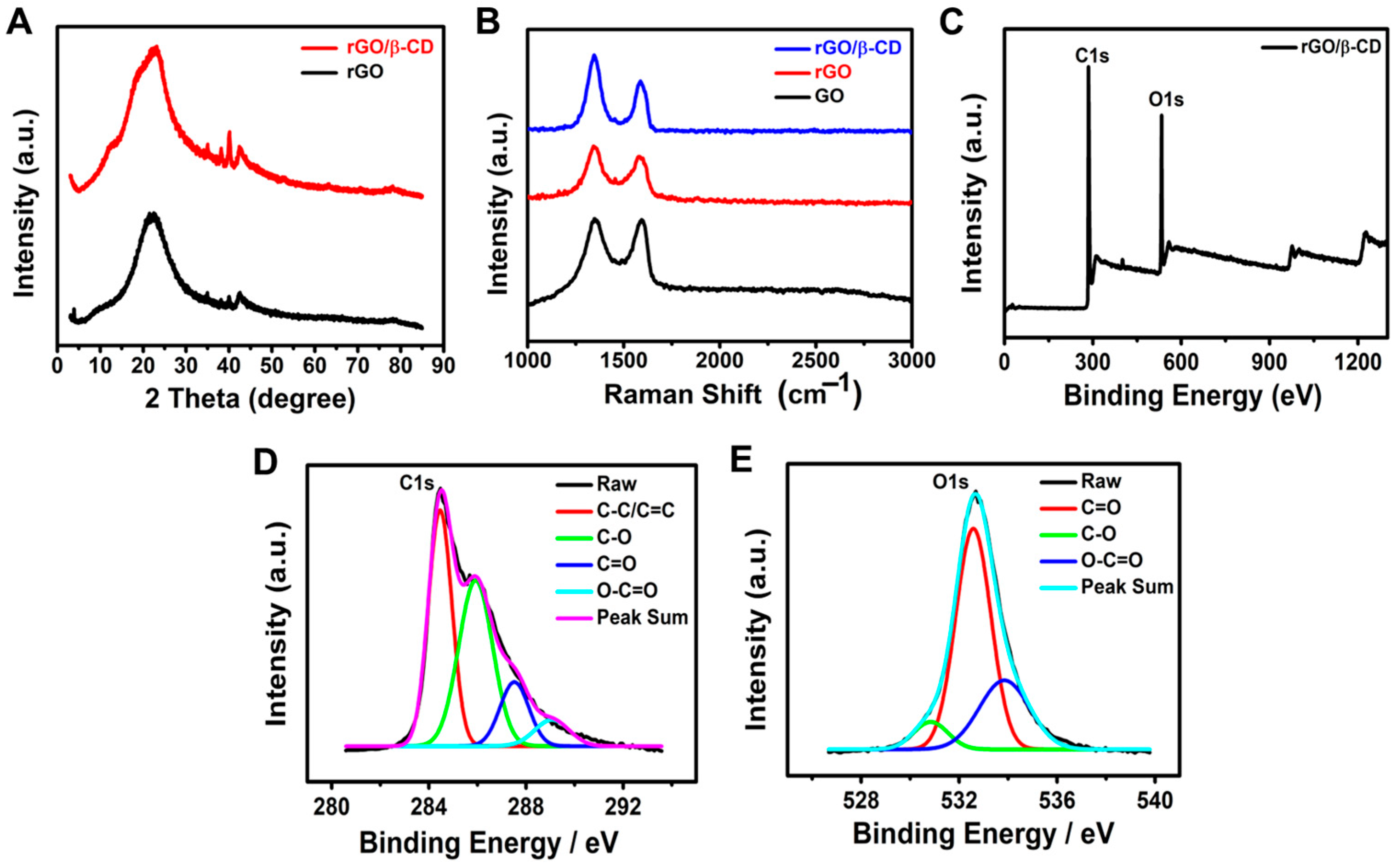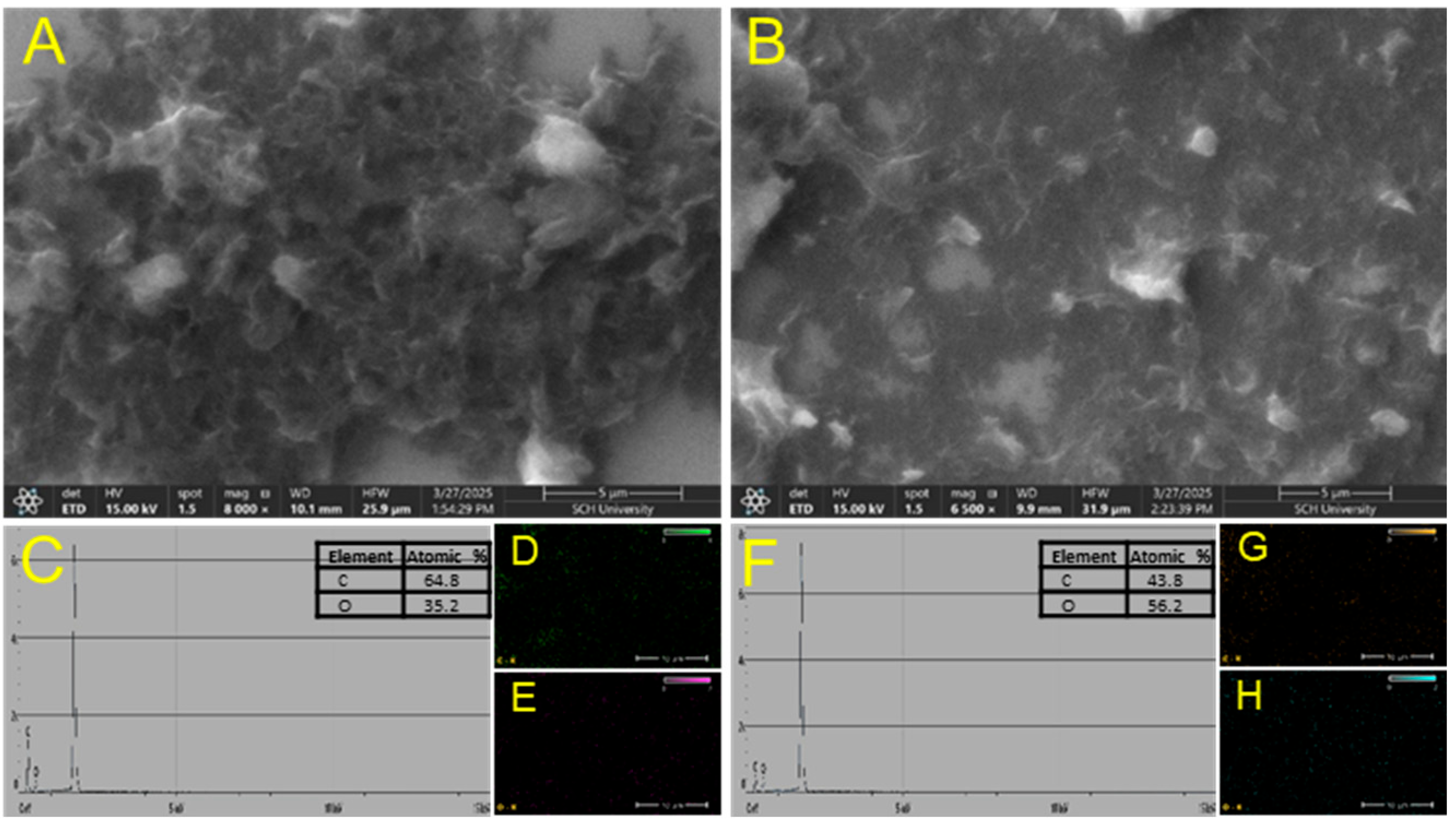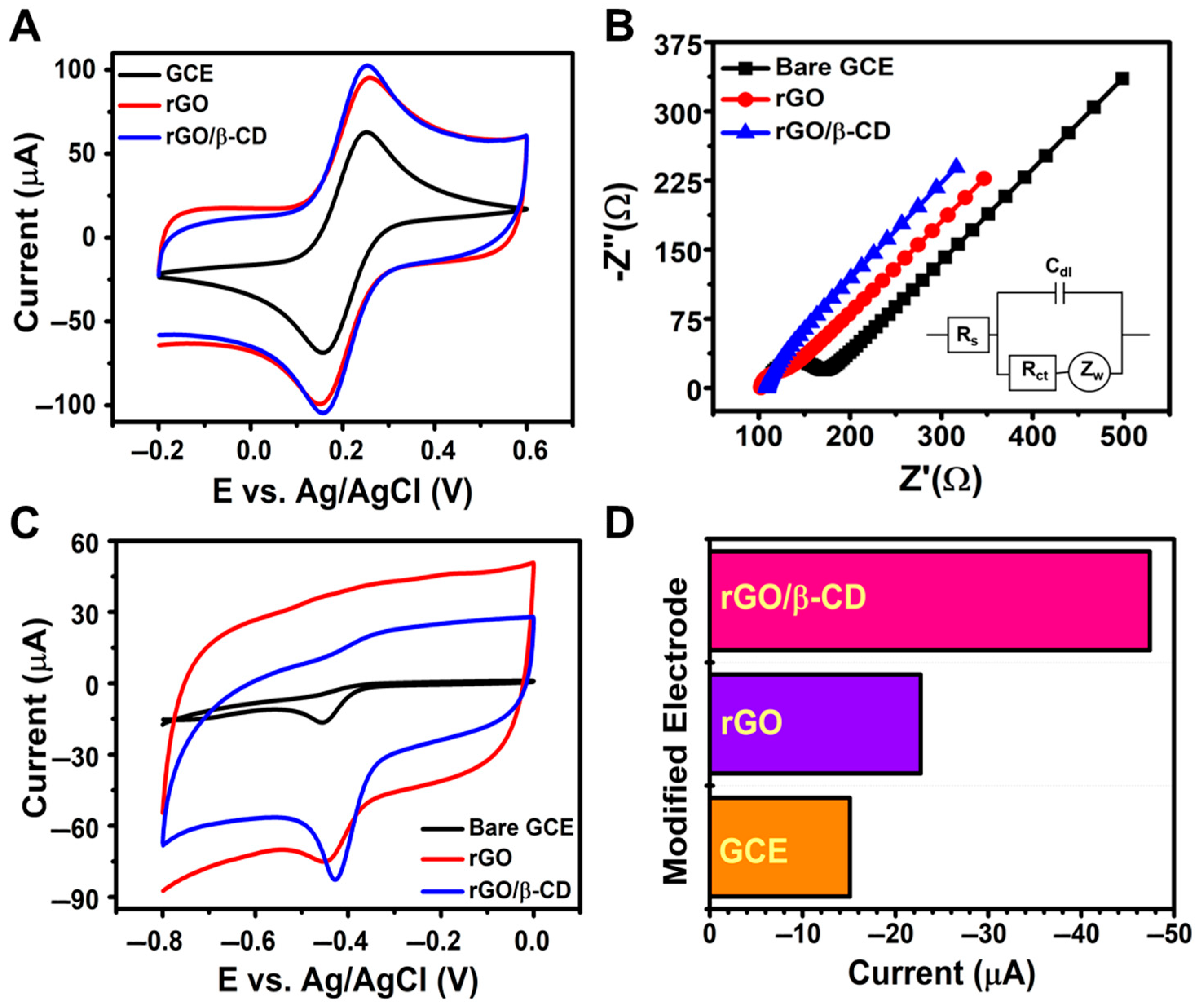Reduced Graphene Oxide/β-Cyclodextrin Nanocomposite for the Electrochemical Detection of Nitrofurantoin
Abstract
1. Introduction
2. Materials and Methods
2.1. Materials
2.2. Instruments
2.3. Synthesis of rGO/β-CD Nanocomposite
2.4. Fabrication of a rGO/β-CD/GCE Modified Electrode
3. Results and Discussion
3.1. Physical Characterization of the rGO/β-CD Nanocomposite
3.2. Electrochemical Behavior of rGO/β-CD/GCE
3.3. Optimization of Electrochemical Detection Parameters
3.4. Electrochemical Sensing Performance and Reliability Evaluation
3.5. Detection of NFT in Real Samples
4. Conclusions
Supplementary Materials
Author Contributions
Funding
Institutional Review Board Statement
Informed Consent Statement
Data Availability Statement
Conflicts of Interest
References
- Li, M.; Zhe, T.; Li, R.; Bai, F.; Jia, P.; Xu, Z.; Wang, X.; Bu, T.; Wu, H.; Wang, L. ZIF-Derived Co Nanoparticles Embedded into N-Doped Carbon Nanotube Composites for Highly Efficient Electrochemical Detection of Nitrofurantoin in Food. Food Chem. 2023, 418, 135948. [Google Scholar] [CrossRef] [PubMed]
- Kokulnathan, T.; Wang, T.-J. Synthesis and Characterization of 3D Flower-like Nickel Oxide Entrapped on Boron Doped Carbon Nitride Nanocomposite: An Efficient Catalyst for the Electrochemical Detection of Nitrofurantoin. Compos. Part B Eng. 2019, 174, 106914. [Google Scholar] [CrossRef]
- Sridharan, G.; Godwin, C.J.T.; Atchudan, R.; Arya, S.; Govindasamy, M.; Osman, S.M.; Sundramoorthy, A.K. Iron Oxide Decorated Hexagonal Boron Nitride Modified Electrochemical Sensor for the Detection of Nitrofurantoin in Human Urine Samples. J. Taiwan Inst. Chem. Eng. 2024, 163, 105320. [Google Scholar] [CrossRef]
- Athikomrattanakul, U.; Katterle, M.; Gajovic-Eichelmann, N.; Scheller, F.W. Development of Molecularly Imprinted Polymers for the Binding of Nitrofurantoin. Biosens. Bioelectron. 2009, 25, 82–87. [Google Scholar] [CrossRef]
- Vinoth Kumar, J.; Karthik, R.; Chen, S.-M.; Chen, K.-H.; Sakthinathan, S.; Muthuraj, V.; Chiu, T.-W. Design of Novel 3D Flower-like Neodymium Molybdate: An Efficient and Challenging Catalyst for Sensing and Destroying Pulmonary Toxicity Antibiotic Drug Nitrofurantoin. Chem. Eng. J. 2018, 346, 11–23. [Google Scholar] [CrossRef]
- Lee, A.C.; Mullany, L.C.; Koffi, A.K.; Rafiqullah, I.; Khanam, R.; Folger, L.V.; Rahman, M.; Mitra, D.K.; Labrique, A.; Christian, P.; et al. Urinary Tract Infections in Pregnancy in a Rural Population of Bangladesh: Population-Based Prevalence, Risk Factors, Etiology, and Antibiotic Resistance. BMC Pregnancy Childbirth 2019, 20, 1. [Google Scholar] [CrossRef]
- Cooper, K.M.; Mulder, P.P.J.; van Rhijn, J.A.; Kovacsics, L.; McCracken, R.J.; Young, P.B.; Kennedy, D.G. Depletion of Four Nitrofuran Antibiotics and Their Tissue-Bound Metabolites in Porcine Tissues and Determination Using LC-MS/MS and HPLC-UV. Food Addit. Contam. 2005, 22, 406–414. [Google Scholar] [CrossRef]
- O’Keeffe, M.; Conneely, A.; Cooper, K.M.; Kennedy, D.G.; Kovacsics, L.; Fodor, A.; Mulder, P.P.J.; van Rhijn, J.A.; Trigueros, G. Nitrofuran Antibiotic Residues in Pork: The FoodBRAND Retail Survey. Anal. Chim. Acta 2004, 520, 125–131. [Google Scholar] [CrossRef]
- Kaufmann, A.; Butcher, P.; Maden, K.; Walker, S.; Widmer, M. Determination of Nitrofuran and Chloramphenicol Residues by High Resolution Mass Spectrometry versus Tandem Quadrupole Mass Spectrometry. Anal. Chim. Acta 2015, 862, 41–52. [Google Scholar] [CrossRef]
- Ultrafast Green Synthesis of Silver Nanoparticles as Fluorescent Nanosensors for Determination of Isoniazid and Nitrofurantoin in Biological Fluids and Pharmaceuticals|Scientific Reports. Available online: https://www.nature.com/articles/s41598-025-98373-6 (accessed on 4 June 2025).
- Hadi, H.; Mouayed, M. Determination of Nitrofurantoin in Pharmaceutical Preparations Using Flow Injection-Spectrophotometry. J. Assoc. Arab Univ. Basic Appl. Sci. 2017, 24, 74–80. [Google Scholar] [CrossRef]
- Patel, D.S.; Sharma, N.; Patel, M.C.; Patel, B.N.; Shrivastav, P.S.; Sanyal, M. Quantitation of Nitrofurantoin in Human Plasma by Liquid Chromatography Tandem Mass Spectrometry. Acta Pharm. 2013, 63, 141–158. [Google Scholar] [CrossRef]
- Al, A.; Prasad, G.V.; Jang, S.J.; Kim, T.H. Flower-like Nickel Oxide/Carbon Nanotube Nanocomposite for Sensitive Electrochemical Detection of Alfuzosin. J. Electrochem. Sci. Technol. 2025, 12, 234. [Google Scholar] [CrossRef]
- Al, A.; Prasad, G.V.; Jang, S.J.; Oh, J.-W.; Kim, T.H. A MOF-Templated Double-Shelled Co3O4/NiCo2O4 Nanocomposite for Electrochemical Detection of Alfuzosin. Nanomaterials 2024, 14, 757. [Google Scholar] [CrossRef] [PubMed]
- Lopes, L.C.; Santos, A.; Bueno, P.R. An Outlook on Electrochemical Approaches for Molecular Diagnostics Assays and Discussions on the Limitations of Miniaturized Technologies for Point-of-Care Devices. Sens. Actuators Rep. 2022, 4, 100087. [Google Scholar] [CrossRef]
- Zhang, X.-J.; Wang, G.-S.; Cao, W.-Q.; Wei, Y.-Z.; Cao, M.-S.; Guo, L. Fabrication of Multi-Functional PVDF/RGO Composites via a Simple Thermal Reduction Process and Their Enhanced Electromagnetic Wave Absorption and Dielectric Properties. RSC Adv. 2014, 4, 18594–19601. [Google Scholar] [CrossRef]
- Butler, S.Z.; Hollen, S.M.; Cao, L.; Cui, Y.; Gupta, J.A.; Gutiérrez, H.R.; Heinz, T.F.; Hong, S.S.; Huang, J.; Ismach, A.F.; et al. Progress, Challenges, and Opportunities in Two-Dimensional Materials Beyond Graphene. ACS Nano 2013, 7, 2898–2926. [Google Scholar] [CrossRef] [PubMed]
- Graphene, Related Two-Dimensional Crystals, and Hybrid Systems for Energy Conversion and Storage|Science. Available online: https://www.science.org/doi/abs/10.1126/science.1246501 (accessed on 4 June 2025).
- Thermal Properties of Graphene and Nanostructured Carbon Materials|Nature Materials. Available online: https://www.nature.com/articles/nmat3064 (accessed on 4 June 2025).
- Pham, T.S.H.; Fu, L.; Mahon, P.; Lai, G.; Yu, A. Fabrication of β-Cyclodextrin-Functionalized Reduced Graphene Oxide and Its Application for Electrocatalytic Detection of Carbendazim. Electrocatalysis 2016, 7, 411–419. [Google Scholar] [CrossRef]
- Park, C.S.; Yoon, H.; Kwon, O.S. Graphene-Based Nanoelectronic Biosensors. J. Ind. Eng. Chem. 2016, 38, 13–22. [Google Scholar] [CrossRef]
- Miller, E.E.; Hua, Y.; Tezel, F.H. Materials for Energy Storage: Review of Electrode Materials and Methods of Increasing Capacitance for Supercapacitors. J. Energy Storage 2018, 20, 30–40. [Google Scholar] [CrossRef]
- Sonpir, R.; Dake, D.; Raskar, N.; Mane, V.; Dole, B. Smart and Advanced Nanocomposites of rGO-Based Ni-Doped Co3O4/TiO2 for next-Level Photocatalysis and Gas Sensing Application. Environ. Sci. Pollut. Res. 2025, 32, 1308–1330. [Google Scholar] [CrossRef]
- Tian, Y.; Guo, N.; Wang, W.-Y.; Geng, W.; Jing, L.-C.; Wang, T.; Yuan, X.-T.; Zhu, Z.; Ma, Y.; Geng, H.-Z. Bilayer and Three Dimensional Conductive Network Composed by SnCl2 Reduced rGO with CNTs and GO Applied in Transparent Conductive Films. Sci. Rep. 2021, 11, 9891. [Google Scholar] [CrossRef] [PubMed]
- Vinothkumar, V.; Sekhar, Y.C.; Chen, S.-M.; Kim, T.H. Development of Sensitive Mn@TiO2/RGO Nanocomposite-Based Sensor for the Detection of Sunset Yellow in Food Samples. FlatChem 2025, 51, 100861. [Google Scholar] [CrossRef]
- Abbas, N.; Jang, S.J.; Kim, T.H. Cytosine-Rich Oligonucleotide and Electrochemically Reduced Graphene Oxide Nanocomposite for Ultrasensitive Electrochemical Ag+ Sensing. Nanomaterials 2024, 14, 775. [Google Scholar] [CrossRef]
- Xu, L.Q.; Wang, L.; Zhang, B.; Lim, C.H.; Chen, Y.; Neoh, K.-G.; Kang, E.-T.; Fu, G.D. Functionalization of Reduced Graphene Oxide Nanosheets via Stacking Interactions with the Fluorescent and Water-Soluble Perylene Bisimide-Containing Polymers. Polymer 2011, 52, 2376–2383. [Google Scholar] [CrossRef]
- Guo, Y.; Guo, S.; Ren, J.; Zhai, Y.; Dong, S.; Wang, E. Cyclodextrin Functionalized Graphene Nanosheets with High Supramolecular Recognition Capability: Synthesis and Host−Guest Inclusion for Enhanced Electrochemical Performance. ACS Nano 2010, 4, 4001–4010. [Google Scholar] [CrossRef] [PubMed]
- Rekharsky, M.V.; Inoue, Y. Complexation Thermodynamics of Cyclodextrins. Chem. Rev. 1998, 98, 1875–1918. [Google Scholar] [CrossRef] [PubMed]
- Fu, L.; Lai, G.; Yu, A. Preparation of β-Cyclodextrin Functionalized Reduced Graphene Oxide: Application for Electrochemical Determination of Paracetamol. RSC Adv. 2015, 5, 76973–76978. [Google Scholar] [CrossRef]
- Zhao, Y.; Zheng, X.; Wang, Q.; Zhe, T.; Bai, Y.; Bu, T.; Zhang, M.; Wang, L. Electrochemical Behavior of Reduced Graphene Oxide/Cyclodextrins Sensors for Ultrasensitive Detection of Imidacloprid in Brown Rice. Food Chem. 2020, 333, 127495. [Google Scholar] [CrossRef]
- Le, H.N.; Jeong, H. kyung β-Cyclodextrin–Graphite Oxide–Carbon Nanotube Composite for Enhanced Electrochemical Supramolecular Recognition. J. Phys. Chem. C 2015, 119, 18671–18677. [Google Scholar] [CrossRef]
- Jiang, Z.; Li, G.; Zhang, M. Electrochemical Sensor Based on Electro-Polymerization of β-Cyclodextrin and Reduced-Graphene Oxide on Glassy Carbon Electrode for Determination of Gatifloxacin. Sens. Actuators B Chem. 2016, 228, 59–65. [Google Scholar] [CrossRef]
- Ghanbari, M.H.; Shahdost-fard, F.; Khoshroo, A.; Rahimi-Nasrabadi, M.; Ganjali, M.R.; Wysokowski, M.; Rębiś, T.; Żółtowska-Aksamitowska, S.; Jesionowski, T.; Rahimi, P.; et al. A Nanocomposite Consisting of Reduced Graphene Oxide and Electropolymerized β-Cyclodextrin for Voltammetric Sensing of Levofloxacin. Microchim. Acta 2019, 186, 438. [Google Scholar] [CrossRef] [PubMed]
- Zor, E.; Bingol, H.; Ramanaviciene, A.; Ramanavicius, A.; Ersoz, M. An Electrochemical and Computational Study for Discrimination of d—And l -Cystine by Reduced Graphene Oxide/β-Cyclodextrin. Analyst 2015, 140, 313–321. [Google Scholar] [CrossRef]
- Hummers, W.S.; Offeman, R.E. Preparation of Graphitic Oxide. J. Am. Chem. Soc. 1958, 80, 1339. [Google Scholar] [CrossRef]
- Song, Z.; Wang, M.; Wang, Z.; Wang, Y.; Li, R.; Zhang, Y.; Liu, C.; Liu, Y.; Xu, B.; Qi, F. Insights into Heteroatom-Doped Graphene for Catalytic Ozonation: Active Centers, Reactive Oxygen Species Evolution, and Catalytic Mechanism. Environ. Sci. Technol. 2019, 53, 5337–5348. [Google Scholar] [CrossRef]
- Feng, X.; Qiu, B.; Dang, Y.; Sun, D. Enhanced Adsorption of Naproxen from Aquatic Environments by β-Cyclodextrin-Immobilized Reduced Graphene Oxide. Chem. Eng. J. 2021, 412, 128710. [Google Scholar] [CrossRef]
- Lai, K.C.; Lee, L.Y.; Hiew, B.Y.Z.; Thangalazhy-Gopakumar, S.; Gan, S. Environmental Application of Three-Dimensional Graphene Materials as Adsorbents for Dyes and Heavy Metals: Review on Ice-Templating Method and Adsorption Mechanisms. J. Environ. Sci. 2019, 79, 174–199. [Google Scholar] [CrossRef]
- Shi, Y.-C.; Wang, A.-J.; Wu, X.-L.; Chen, J.-R.; Feng, J.-J. Green-Assembly of Three-Dimensional Porous Graphene Hydrogels for Efficient Removal of Organic Dyes. J. Colloid Interface Sci. 2016, 484, 254–262. [Google Scholar] [CrossRef]
- Si, K.; Sun, C.; Cheng, S.; Wang, Y.; Hu, W. Cyclodextrin Functionalized Reduced Graphene Oxide for Electrochemical Chiral Differentiation of Tartaric Acid. Anal. Methods 2018, 10, 3660–3665. [Google Scholar] [CrossRef]
- Nikhil, S.; Karthika, A.; Suresh, P.; Suganthi, A.; Rajarajan, M. A Selective and Sensitive Electrochemical Determination of Catechol Based on Reduced Graphene Oxide Decorated β-Cyclodextrin Nanosheet Modified Glassy Carbon Electrode. Adv. Powder Technol. 2021, 32, 2148–2159. [Google Scholar] [CrossRef]
- Wang, J.; Chen, B. Adsorption and Coadsorption of Organic Pollutants and a Heavy Metal by Graphene Oxide and Reduced Graphene Materials. Chem. Eng. J. 2015, 281, 379–388. [Google Scholar] [CrossRef]
- Xie, G.; Xi, P.; Liu, H.; Chen, F.; Huang, L.; Shi, Y.; Hou, F.; Zeng, Z.; Shao, C.; Wang, J. A Facile Chemical Method to Produce Superparamagnetic Graphene Oxide–Fe3O4 Hybrid Composite and Its Application in the Removal of Dyes from Aqueous Solution. J. Mater. Chem. 2011, 22, 1033–1039. [Google Scholar] [CrossRef]
- Sun, Z.; Zhao, L.; Liu, C.; Zhen, Y.; Zhang, W.; Ma, J. A Novel 3D Adsorbent of Reduced Graphene Oxide-β-Cyclodextrin Aerogel Coupled Hardness with Softness for Efficient Removal of Bisphenol A. Chem. Eng. J. 2019, 372, 896–904. [Google Scholar] [CrossRef]
- Fang, Z.; Li, Q.; Su, L.; Chen, J.; Chou, K.-C.; Hou, X. Efficient Synergy of Photocatalysis and Adsorption of Hexavalent Chromium and Rhodamine B over Al4SiC4/rGO Hybrid Photocatalyst under Visible-Light Irradiation. Appl. Catal. B Environ. 2019, 241, 548–560. [Google Scholar] [CrossRef]
- Kang, Y.; Wang, L.; Wang, Y.; Zhang, H.; Wang, Y.; Hong, D.; Qv, Y.; Wang, S. Construction and Enhanced Gas Sensing Performances of CuO-Modified α-Fe2O3 Hybrid Hollow Spheres. Sens. Actuators B Chem. 2013, 177, 570–576. [Google Scholar] [CrossRef]
- Lu, D.; Lin, S.; Wang, L.; Shi, X.; Wang, C.; Zhang, Y. Synthesis of Cyclodextrin-Reduced Graphene Oxide Hybrid Nanosheets for Sensitivity Enhanced Electrochemical Determination of Diethylstilbestrol. Electrochim. Acta 2012, 85, 131–138. [Google Scholar] [CrossRef]
- Zhang, M.; Zhang, H.; Zhai, X.; Yang, X.; Zhao, H.; Wang, J.; Dong, A.; Wang, Z. Application of β-Cyclodextrin–Reduced Graphene Oxide Nanosheets for Enhanced Electrochemical Sensing of the Nitenpyram Residue in Real Samples. New J. Chem. 2017, 41, 2169–2177. [Google Scholar] [CrossRef]
- Yun, N.; Lu, C.; Sun, T.; Xu, B.; Song, Y.; Zong, Z.; Chen, K.; Huang, G.; Chen, X.; Gu, Q. High Sensitivity Detection of Capsaicin in Red Pepper Oil Based on Reduced Graphene Oxide Enhanced by β-Cyclodextrin. Food Anal. Methods 2023, 16, 318–329. [Google Scholar] [CrossRef]
- Mirzaei, B.; Zarrabi, A.; Noorbakhsh, A.; Amini, A.; Makvandi, P. A Reduced Graphene Oxide-β-Cyclodextrin Nanocomposite-Based Electrode for Electrochemical Detection of Curcumin. RSC Adv. 2021, 11, 7862–7872. [Google Scholar] [CrossRef]
- Vishwanath, M.S.; Swamy, B.E.K.; Vishnumurthy, K.A. Electrochemical Detection of Bisphenol A in Presence of Catechol and Hydroquinone at Copper Oxide Modified Carbon Paste Electrode. Mater. Chem. Phys. 2022, 289, 126443. [Google Scholar] [CrossRef]
- Gerent, G.G.; Spinelli, A. Magnetite-Platinum Nanoparticles-Modified Glassy Carbon Electrode as Electrochemical Detector for Nitrophenol Isomers. J. Hazard. Mater. 2017, 330, 105–115. [Google Scholar] [CrossRef]
- Silva, E.M.; Takeuchi, R.M.; Santos, A.L. Carbon Nanotubes for Voltammetric Determination of Sulphite in Some Beverages. Food Chem. 2015, 173, 763–769. [Google Scholar] [CrossRef] [PubMed]
- Fogg, A.G.; Ghawji, A.B. Reductive Amperometric Determination of Nitrofurantoin and Acetazolamide at a Sessile Mercury Drop Electrode Using Flow Injection Analysis. Analyst 1988, 113, 727–730. [Google Scholar] [CrossRef]
- Ghawji, A.B.; Fogg, A.G. Reduction in Size by Electrochemical Pre-Treatment at High Negative Potentials of the Background Currents Obtained at Negative Potentials at Glassy Carbon Electrodes and Its Application in the Reductive Flow Injection Amperometric Determination of Nitrofurantoin. Analyst 1986, 111, 157–161. [Google Scholar] [CrossRef]
- Aydoğdu, G.; Günendi, G.; Zeybek, D.K.; Zeybek, B.; Pekyardımcı, Ş. A Novel Electrochemical DNA Biosensor Based on Poly-(5-Amino-2-Mercapto-1,3,4-Thiadiazole) Modified Glassy Carbon Electrode for the Determination of Nitrofurantoin. Sens. Actuators B Chem. 2014, 197, 211–219. [Google Scholar] [CrossRef]
- Voltammetric Determination of Nitrofurantoin at a Mercury Meniscus Modified Silver Solid Amalgam Electrode—Krejčová—2015—Electroanalysis—Wiley Online Library. Available online: https://analyticalsciencejournals.onlinelibrary.wiley.com/doi/full/10.1002/elan.201400410 (accessed on 5 June 2025).
- Rudayni, H.A.; Chaudhary, A.A.; Abu-Taweel, G.M.; Shariq, M.; Imran, M. Hydrothermal Synthesis of CeO2 Nanoparticles and Its Application in Electrochemical Detection of Nitrofurantoin Antibiotics. Europhys. Lett. 2022, 137, 66005. [Google Scholar] [CrossRef]
- He, B.; Li, J. A Sensitive Electrochemical Sensor Based on Reduced Graphene Oxide/Fe3O4 Nanorod Composites for Detection of Nitrofurantoin and Its Metabolite. Anal. Methods 2019, 11, 1427–1435. [Google Scholar] [CrossRef]







| Working Electrode | Method | Linear Range (µM) | LOD (µM) | Sensitivity μA·μM−1·cm−2 | Potential, V | Ref. |
|---|---|---|---|---|---|---|
| SMDE | FIA | 4.2–210 | 1.26 | ~ | −0.70 | [55] |
| EC-GCE | FIA | 0.2–1.0 | 0.2 | ~ | −0.58 | [56] |
| GCE/PAMT/dsDNA | DPV | 8.4–105.0 | 2.73 | ~ | 0.82 | [57] |
| m-AgSAE | DPV | 0.2–100 | 0.08 | ~ | 0.38 | [58] |
| CeO2 NPs | DPV | - | 7.81 | 1.15 | 0.52 | [59] |
| rGO/Fe3O4NRs/GCE | DPV | 0.1–100 | 0.083 | ~ | 0.42 | [60] |
| rGO/β-CD/GCE | DPV | 0.5–120 | 0.048 | 12.1 | 0.429 | This Work |
| Samples | Added (µM) | Found (µM) | Recovery (%) | RSD (%) |
|---|---|---|---|---|
| Wastewater | 5 | 5.07 | 101.42 | 3.18 |
| 10 | 9.86 | 98.57 | 2.34 | |
| 15 | 14.92 | 99.45 | 1.47 | |
| 20 | 19.54 | 97.70 | 3.24 |
Disclaimer/Publisher’s Note: The statements, opinions and data contained in all publications are solely those of the individual author(s) and contributor(s) and not of MDPI and/or the editor(s). MDPI and/or the editor(s) disclaim responsibility for any injury to people or property resulting from any ideas, methods, instructions or products referred to in the content. |
© 2025 by the authors. Licensee MDPI, Basel, Switzerland. This article is an open access article distributed under the terms and conditions of the Creative Commons Attribution (CC BY) license (https://creativecommons.org/licenses/by/4.0/).
Share and Cite
Amin, A.; Prasad, G.V.; Vinothkumar, V.; Jang, S.J.; Oh, D.E.; Kim, T.H. Reduced Graphene Oxide/β-Cyclodextrin Nanocomposite for the Electrochemical Detection of Nitrofurantoin. Chemosensors 2025, 13, 247. https://doi.org/10.3390/chemosensors13070247
Amin A, Prasad GV, Vinothkumar V, Jang SJ, Oh DE, Kim TH. Reduced Graphene Oxide/β-Cyclodextrin Nanocomposite for the Electrochemical Detection of Nitrofurantoin. Chemosensors. 2025; 13(7):247. https://doi.org/10.3390/chemosensors13070247
Chicago/Turabian StyleAmin, Al, Gajapaneni Venkata Prasad, Venkatachalam Vinothkumar, Seung Joo Jang, Da Eun Oh, and Tae Hyun Kim. 2025. "Reduced Graphene Oxide/β-Cyclodextrin Nanocomposite for the Electrochemical Detection of Nitrofurantoin" Chemosensors 13, no. 7: 247. https://doi.org/10.3390/chemosensors13070247
APA StyleAmin, A., Prasad, G. V., Vinothkumar, V., Jang, S. J., Oh, D. E., & Kim, T. H. (2025). Reduced Graphene Oxide/β-Cyclodextrin Nanocomposite for the Electrochemical Detection of Nitrofurantoin. Chemosensors, 13(7), 247. https://doi.org/10.3390/chemosensors13070247






